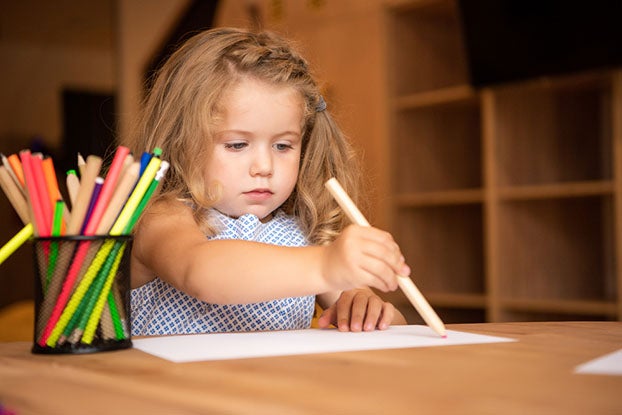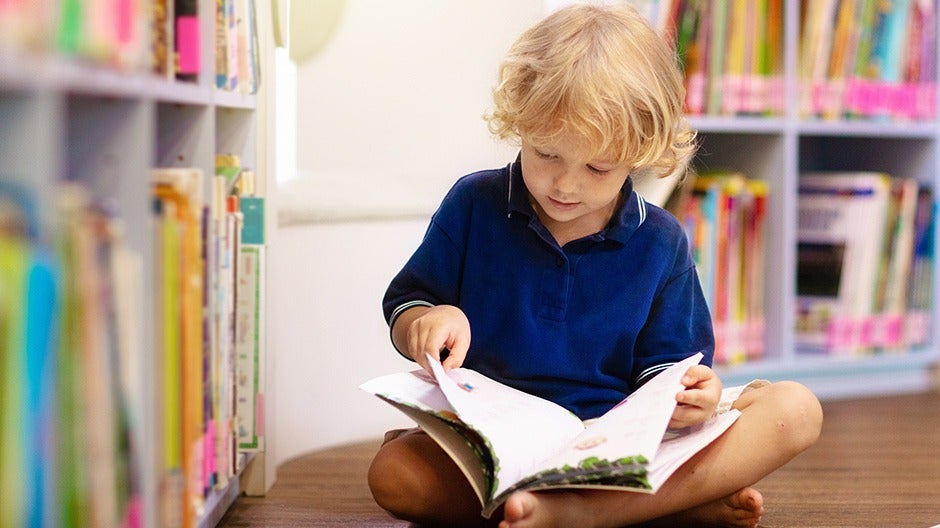At Begin, we believe in giving children a solid math foundation. Why is this important? Well, without developing essential early math skills, it’s challenging for a child to grasp more complex mathematical problems as they get older.
That may seem like a lot of pressure as a parent, but don’t worry, that’s what the Begin team is here for!
In this article, we’ll be focusing on cardinal numbers in particular. First, we’ll help you understand what they are and how they work. Then, our experts will share several fun and educational learning activities to help your young learner get comfortable with this concept.
Let’s dive in!
Table of Contents
- What Are Cardinal Numbers?
- Differences Between Ordinal And Cardinal Numbers
- 12 Fun Activities To Teach Cardinal Numbers
What Are Cardinal Numbers?
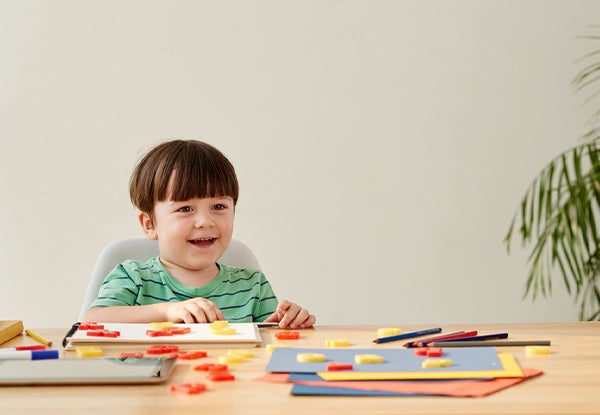
Cardinal numbers are the numbers we use for counting and so are also called counting numbers. For example, if someone asks, “How many cookies are in the jar?” we use cardinal numbers (i.e., one, two, three, etc.) to count and determine the amount.
Learning to count with cardinal numbers is one of the most important math skills a child must master. This ability is central to almost all other math work a child will be asked to do. All the operations, from addition to division, require a thorough understanding of cardinal numbers.
Plus, they’re an integral part of daily life and play a crucial role in the development of essential life skills such as:
- Time management
- Money concepts
- Problem-solving
- Measuring and quantity estimation
Learning about cardinal numbers unlocks a whole new world of possibilities for your child, helping them understand and navigate the world more efficiently.
There are steps in learning these numbers both in terms of how high you count and how you count. Children might begin by mastering 1-5 and then 1-10 and then 1-20…and then 1-100!
There are other aspects of learning cardinal numbers, as well. Kids will learn to recognize (and write) the symbols that represent the numbers they count, and they will begin to understand that the last number you say represents all of the items in the group you are counting.
How Do You Write Them?
Cardinal numbers refer to a set of real-life objects. You can either write them in numerical form (e.g., 1, 2, 3, 4, etc.) or spell them out as words (e.g., one, two, three, four, etc.). It’s as easy as that!
The math activities below will focus on helping children get comfortable with counting as well as recognizing number symbols — two important factors when learning the principles of cardinal numbers.
It’s important to note here that it might take your child a while to write cardinal numbers correctly. For example, lots of kids write the number 5 backward, and young children often reverse the order of two-digit numbers (41 for fourteen) because they hear the 4 first.
That’s OK! Like with all learning objectives, each child is unique and will learn at a different pace.
Now, before we dive into the games we mentioned above, let’s take a peek at ordinal numbers and how they relate to the topic at hand.
When Can You Teach Kids about Cardinal Numbers?
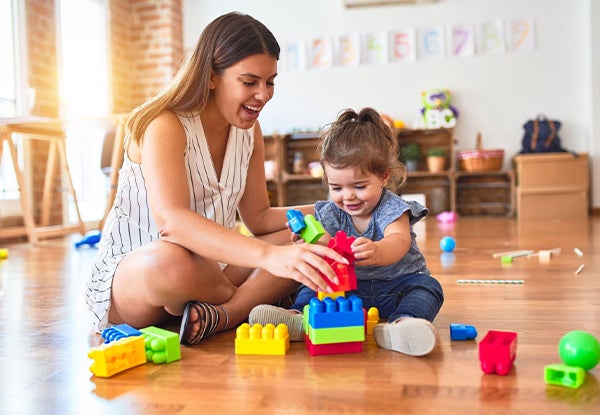
While young learners may not hear the term “cardinal numbers” until they’re in kindergarten or beyond, you can introduce the concept well before then.
You often hear about the importance of reading aloud to babies and toddlers to help them develop early language skills. In the same way, talking about numbers and counting aloud can be an important precursor to learning math skills.
You can incorporate counting into your child’s everyday activities starting when they are very young. Here are some real-life examples:
- Counting fingers and toes during a diaper change
- Counting the steps as you walk upstairs
- Singing counting songs like “Five Little Monkeys” or “One, Two, Buckle My Shoe.”
- Reading aloud counting books such as My Very First Book of Numbers by Eric Carle or Chicka Chicka 1 2 3 by Bill Martin Jr. and Michael Sampson
- Stacking blocks together and counting how many are in your tower
The more your child hears and experiences counting, the more familiar they’ll become with numbers and their order. They’ll continue learning about cardinal numbers throughout elementary school as they learn to count and work with larger numbers like 100 or 1,000
Differences Between Ordinal and Cardinal Numbers
Cardinal numbers are sometimes confused for ordinal numbers, but there are a few fundamental differences between the two.
Ordinal numbers tell us the order of things in a set. For example, after a race, you can communicate that, “Jennifer was second,” or “Timothy was fifth.”
While counting does come into play to communicate ordinal numbers, it’s hard to just express the numbers by themselves (i.e., one, two, three, etc.). Instead, we have to look at a whole series or set to tell what or who is first, second, third, etc.
Cardinal numbers, on the other hand, are strictly used for counting because they tell us how many items there are. For example, “There are five apples in the fridge.”
As you can see, sometimes it can be challenging to distinguish between these two types of numbers. But learning through play is a great way to help kids understand these math principles and get comfortable using them in real-life situations.
With all of this in mind, here’s our list of 12 fun and effective games to teach your child cardinal numbers!
12 Fun Activities to Teach Cardinal Numbers
Use these math games and activities to help your toddler or preschooler learn more about cardinal numbers.
1) Frog Hop

What You’ll Need:
- Index cards
- Marker
- A large space (preferably outside)
- Sticky tack
What To Do:
First, write the numbers one through 10 on your index cards (one number per card). Then, place the index cards on the floor in any order, hopping-distance apart. You can use sticky tack to help secure the cards to the ground to prevent a potential slipping situation.
After placing your cards where you’d like them, you’re ready to play. The object of the game is for your child to hop from each of the cards to reach you. But they can’t just hop in a straight line. That would be boring!
Instead, your child will need to listen to your instructions and follow the directions as you tell them which card to jump onto and what to do while on that card.
For example, tell your child: Hop onto number five. Once your child is on that card, give them their second set of instructions: OK, since you’re on number five, you have to jump up and down five times! Ready, go!
Note: The instructions can be anything you want as long as they correspond to the number your child lands on. Wiggles, jumps, claps, and all kinds of silliness are encouraged!
Once they’ve completed your first set of instructions, encourage them to hop onto another number and give them different instructions. This repeats until your child has hopped to every number, and the game ends when they finally reach you.
Frog Hop is a fun activity with many great educational elements, including recognizing number symbols and practicing counting skills. In addition, hopping around and acting silly is a great way for kids to burn some energy!
2) Count Around The House
What You’ll Need:
- Any items you have around the house
What To Do:
This activity is all about using your home to help your child learn cardinal numbers.
To play, simply ask your child how many you have of a specific item around the house. Then, let them walk around and count how many there are!
Here are some ideas to get you brainstorming:
- How many chairs do we have in the living room? What about the whole house?
- How many rooms do we have in the house?
- How many shoes do you have in your closet?
- How many forks are in the drawer?
- How many plates do we have in the kitchen?
- How many mirrors do we have in the house?
You can also give your child a list of items they need to hunt for. For younger children who haven’t started reading yet, drawing pictures of the objects is a great option for this activity.
Once you give them the list, you can set a timer and say: Let’s see if you can count all the items on this list in four minutes!
This is an excellent cardinality game because it lets children work on their counting skills. We also love the fact that you don’t need many resources to play because you will be using whatever is available around your home.
3) Numbered Chocolate Chip Cookies

What You’ll Need:
- Cookie dough
- Chocolate chips
- Your favorite cookie recipe
- Large die
What To Do:
To complete this delicious activity, you’ll need a cookie recipe of your liking.
Mix the ingredients to form your dough. Then, portion out the batter to form your cookies. Before adding your chocolate chips to each cookie, however, you’ll need to determine how many to use by rolling your die.
To do this, encourage your child to roll the die and count the number of dots that it lands on. Then, add that amount of chocolate chips to the cookie dough. If it lands on a small number (e.g., one or two) and they would like more chocolate chips, they can roll again!
Once the rolling and counting are done, place your cookies in the oven and get ready to enjoy some ooey-gooey baked goods when they’re ready!
Not only does this give your child plenty of counting practice, but it also teaches them how a die works and how to follow directions.
It also makes learning oh, so much fun! As soon as your child sees the cookie dough and chocolate chips come out, they’ll be happy to join in!
4) HOMER App by Begin
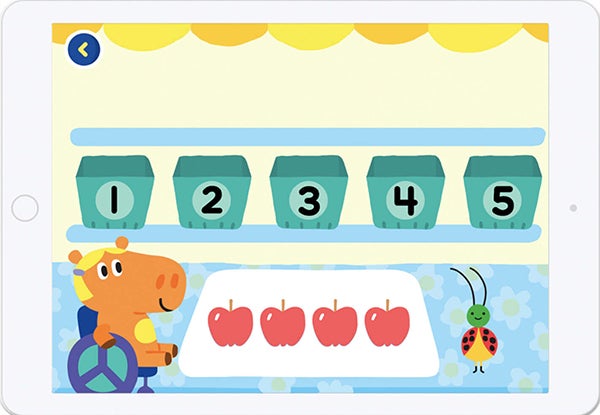
What You’ll Need:
- A subscription to the HOMER app by Begin (start your free trial!)
What to Do:
The award-winning HOMER app by Begin helps build your child’s math confidence through interactive games and activities. As your child engages with the app, they’ll develop a love of numbers and practice counting in songs.
Once you start your free trial, encourage your child to play for 15 minutes a day. The app will guide your child through fun and educational activities while keeping track of their progress so you can see how they’re improving over time.
Plus, math isn’t the only subject your child can practice with the HOMER app. They’ll also build their reading, critical thinking, and social-emotional skills as they play.
5) Cardinal Number Memory
What You’ll Need:
- 5 index cards, cut in half
- A marker
What to Do:
To prepare this simple number-matching game, write a number from 1-5 on each index card half. You should have two of each number. Mix the cards up and lay them face down on a flat surface.
Ask your child to turn over two cards to see if they’re the same. If they are, they make a match and get to keep the cards. If not, it’s your turn. Keep taking turns until the players match all the cards.
This game has unlimited possibilities. Here are a few ideas for making it more challenging:
- Draw large dots on half of the cards. To make a match, you’d need to flip a number and the corresponding number of dots (such as a card with 4 written on it and a card with four dots)
- Add in more numbers, up to 10 or higher
- Use a timer to see how fast your child can match all the cards on their own
- Have your child prepare the cards to practice writing numbers
- Write number words on half the cards. To make a match, you’d need to flip a number and the corresponding number word (such as a “3” card and the word “three.”)
6) Snacky Numbers
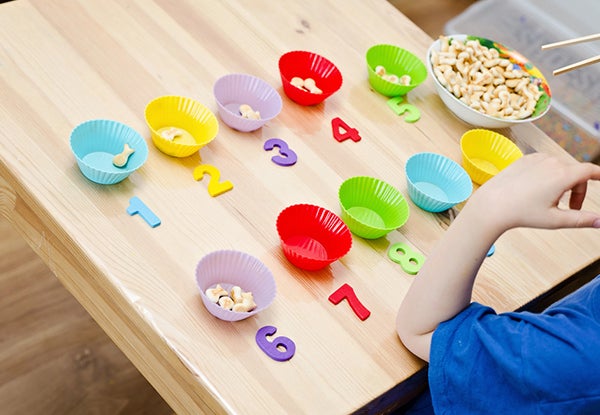
What You’ll Need:
Any kind of small snack your child can safely eat (such as fish crackers, raisins, pretzels, etc.)
10 cupcake liners
Magnetic numbers
What to Do:
Set up the cupcake liners on the table in two rows of five. Underneath each, place a magnetic number.
Place a bowl of the snack next to your child. Challenge them to put the right amount of snack into each cupcake liner.
Encourage your child to count as they go and talk about the numbers they see. You can also contribute to the narrative. For example, “You put five fish crackers in this cupcake liner. The number five is underneath. That’s a match!”
This activity helps young mathematicians practice counting, number recognition, and one-to-one correspondence. If your little one is ready to practice with bigger numbers, use a cupcake tin instead. Here are directions for that version.
7) Picture Count
What You’ll Need:
- A book or magazine with pictures
What to Do:
Instead of reading the book as usual, do a picture count with your child. Let them study the illustration and count the number of a specific item you call out.
For example, if the picture you’re looking at has flowers, ask them to count them. You can use the same picture multiple times, changing the item you want them to count each time.
This activity helps children improve their counting skills and learn to focus on details. They’re also learning one-to-one correspondence as they point to each item as they count.
8) HOMER Early Learning Kits from Begin
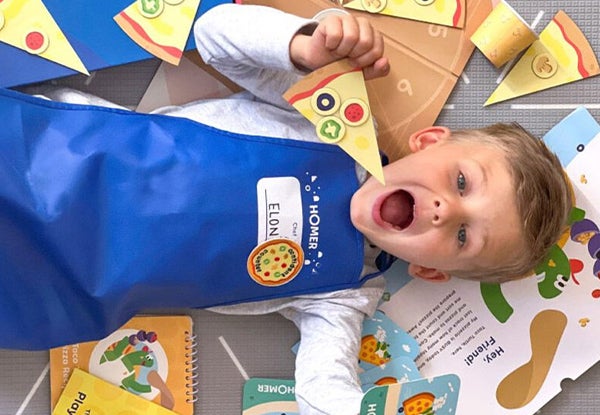
What You’ll Need:
- HOMER Early Learning Kits
What to Do:
Once you sign up for HOMER Early Learning Kits, a box full of fun will be delivered to your doorstep each month! These kits are designed to promote early learning and development in young children through hands-on activities and games.
Each kit focuses on a theme; the second is about numbers and counting. But you don’t have to wait for that box to get started with number fun. The first delivery contains a magnifying glass, puzzle, and letter flashcards (among other things).
You can have your child:
- Use the magnifying glass to spy numbers in their environment
- Count the puzzle pieces
- Look for the five letter cards you hid around the room (then count each one to ensure they found them all)
There are many creative ways to play with numbers in every HOMER Early Learning Kit!
9) Blocks Box
What You’ll Need:
- An empty shoebox
- A set of blocks
- Large die
What to Do:
Have your child roll the die and count the number of dots. Next, have them put that many blocks into the box. Continue until the box is full, and then work together to count the blocks. How many did it take to fill the box?
This activity will help your child practice their number recognition and one-to-one correspondence. It also introduces the concept of addition since they’re adding blocks to the box during each round, and the total number is getting larger.
10) Magnetic Number Hunt
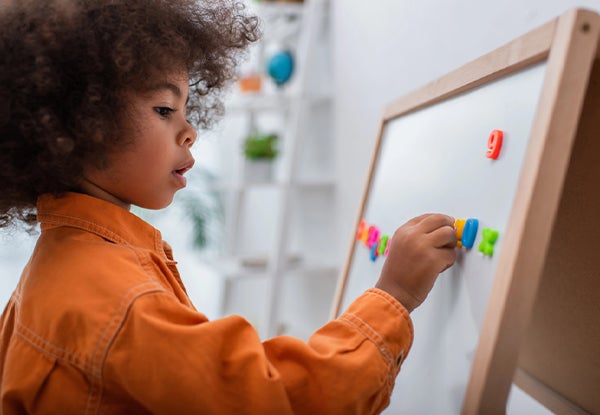
What You’ll Need:
- A set of magnetic numbers, 1-5
What to Do:
Hide the magnetic numbers around the house, sticking them to magnetic surfaces, and ask your child to find them.
Each time they discover a number, have them bring it back to a central location (like the fridge) and place it there. Once your scout locates all the numbers, encourage them to put the numbers in order and count them for you.
With this game, children will practice counting and ordering numbers and learn a little about how magnets work and what types of surfaces they stick to. This scientific concept may spark their curiosity and lead to more questions and learning opportunities.
11) Play Dough Numbers
What You’ll Need:
- Play dough
What to Do:
Ask your child to form the numbers 1-5 out of play dough. Next, have them put the numbers in order and count them for you.
As an extra challenge, have them make the correct number of play dough dots above each number and then count each dot.
This sensory activity helps your child work on number recognition. As they manipulate and mold the playdough, they’ll use fine motor skills and build hand-eye coordination.
12) Mini Number Pizza Printable

What You’ll Need:
- This printable from Begin
- Scissors
- Crayons or colored pencils
- Large die
What to Do:
Print out the printable from Begin. Have your child roll the die for each pizza and write the number they get next to it. Next, they can draw that number of pepperoni pieces or another favorite topping onto each piece using crayons or colored pencils.
After the pizzas are ready, help your child cut them out so they’re ready for more play. You can call and order a pizza with a specific amount of toppings, and they can “deliver” it to you.
They can continue learning about numbers with pizza with the game Taco Turtle’s Pizzeria on the HOMER app by Begin!
Let’s Make Cardinal Numbers Fun!

Cardinal numbers are not just a part of our daily lives; they are also the foundation for almost all the number work your child will encounter in school. Helping our young learners understand these numbers can set them up for success with future mathematical concepts.
One of the best ways to introduce any new math skill to your child is through engaging activities. This helps them have lots of fun while also learning and growing.
The above activities are meant to do exactly that — allow your child to grasp cardinality while also having fun. Whether you choose some or all of them, remember to be patient with your child as they hone their skills. This can help build a lifelong love for math and learning.
For more on early childhood math development, check out the HOMER app from Begin today!




